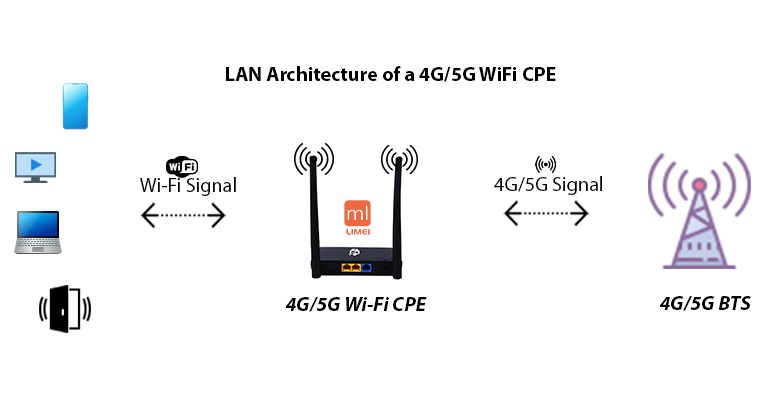LAN architecture of a 4G/5G WiFi CPE router

A 4G/5G WiFi CPE (Customer Premises Equipment)
router typically has a LAN (Local Area Network) architecture that allows it to
connect and distribute network connectivity to multiple devices within a local
area. The LAN architecture of a 4G/5G WiFi CPE router consists of several
components and features:
-
WAN Port: The router has a wide area network (WAN)
port, usually an Ethernet port, that connects to the 5G network provided
by the service provider. This port receives the 5G signal and establishes
the internet connection.
-
LAN Ports: The router also has multiple local area
network (LAN) ports, usually Ethernet ports, which are used to connect
devices such as computers, gaming consoles, smart TVs, etc., to the
router. These LAN ports create a wired connection between the router and
the devices, allowing them to access the internet.
-
Wireless Connectivity: The 5G WiFi CPE router also provides
wireless connectivity, allowing devices to connect to the router without
the need for physical Ethernet connections. It typically supports Wi-Fi
standards such as 802.11ac or 802.11ax (also known as Wi-Fi 5 or Wi-Fi 6,
respectively), providing high-speed wireless connections to compatible
devices.
-
DHCP Server: The router acts as a DHCP (Dynamic Host
Configuration Protocol) server, assigning IP addresses to devices
connected to the LAN. The DHCP server ensures that each device on the
network has a unique IP address and can communicate with other devices.
-
NAT (Network Address
Translation): The router
uses NAT to translate between the local IP addresses assigned to devices
on the LAN and the public IP address provided by the internet service
provider. This allows multiple devices on the LAN to share a single public
IP address.
-
Firewall and Security: The router may have built-in firewall
capabilities to protect the LAN from unauthorized access and potential
threats from the internet. It may support features like port forwarding,
DMZ (Demilitarized Zone), VPN (Virtual Private Network) passthrough, and
other security protocols.
-
Quality of Service (QoS): Some 5G WiFi CPE routers include QoS
features that prioritize certain types of network traffic. This allows you
to allocate bandwidth to specific devices or applications, ensuring
smoother performance for activities like streaming video or online gaming.
-
Management Interface: The router typically provides a web-based
management interface that allows users to configure and customize various
settings, including network security, wireless settings, DHCP settings,
and more.
Overall, the LAN architecture of a 5G WiFi CPE
router enables multiple devices to connect to the router, either through wired
or wireless connections, and share the 5G internet connection provided by the
service provider.

